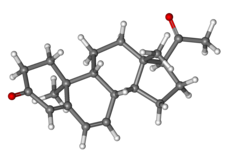Dydrogesterone
 |
|
 |
|
| Clinical data | |
|---|---|
| Trade names | Duphaston, others |
| Synonyms | Isopregnenone; Dehydroprogesterone; Didrogesteron; 6-Dehydroretroprogesterone; 9β,10α-Pregna-4,6-diene-3,20-dione; NSC-92336 |
| AHFS/Drugs.com | International Drug Names |
| Routes of administration |
By mouth |
| Drug class | Progestogen |
| ATC code | |
| Legal status | |
| Legal status |
|
| Pharmacokinetic data | |
| Bioavailability | 28% |
| Protein binding | ? (probably to albumin) |
| Metabolism | Hepatic: AKR1C1, AKR1C3, CYP3A4 |
| Metabolites | 20α-DHD (exclusively via AKR1C1 and AKRC13) |
| Biological half-life |
Parent: 5–7 hours Metabolite: 14–17 hours |
| Identifiers | |
|
|
| CAS Number | |
| PubChem CID | |
| DrugBank | |
| ChemSpider | |
| UNII | |
| KEGG | |
| ChEBI | |
| ECHA InfoCard | 100.005.280 |
| Chemical and physical data | |
| Formula | C21H28O2 |
| Molar mass | 312.446 g/mol |
| 3D model (JSmol) | |
| Melting point | 144 °C (291 °F) |
| Boiling point | 463 °C (865 °F) |
| Solubility in water | Insoluble mg/mL (20 °C) |
|
|
|
|
Dydrogesterone, sold under the brand name Duphaston among others, is a progestin which was developed in the 1950s and introduced for clinical use in 1961. It is available widely throughout Europe, including the United Kingdom and many other European countries, and is also marketed in Australia and elsewhere in the world. The drug was previously marketed in the United States as well, but is now no longer available in this country.
Dydrogesterone has selective progestational activity and does not inhibit ovulation. The greater rigidity of dydrogesterone also positively affects its selectivity, while natural progesterone is less selective, existing in different conformations that more easily bind to different receptors. As a consequence of its better bioavailability and the progestational activity of its main metabolites (20-, 21- and 16-hydroxy derivatives), the equivalent dose of dydrogesterone is 10–20 times lower than that of oral micronized progesterone.
Dydrogesterone is used as an effective, orally active progestogen for gynecological conditions related to a wide variety of progesterone deficiencies in pregnant women. The molecular structure and pharmacological effects are somewhat similar to endogenous progesterone, although in smaller amounts it is found to be orally active. Its freedom from hormonal effects like those related to corticoid, androgenic, estrogenic, anabolic, and other effects gives dydrogesterone an advantage over other synthesized progestogens.
...
Wikipedia
